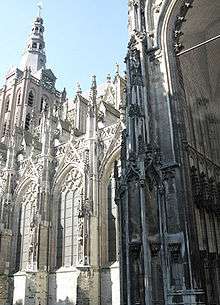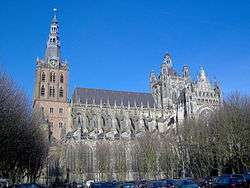St. John's Cathedral ('s-Hertogenbosch)
| Cathedral Basilica of St. John the Evangelist | |
|---|---|
|
St. John's Cathedral | |
| Basic information | |
| Location | 's-Hertogenbosch, Netherlands |
| Geographic coordinates | 51°41′17″N 5°18′27″E / 51.68806°N 5.30750°E |
| Affiliation | Roman Catholic |
| Rite | Latin Rite |
| District | bishopric of 's-Hertogenbosch |
| Province | North Brabant |
| Ecclesiastical or organizational status | Cathedral |
| Heritage designation | Rijksmonument |
| Website | http://www.sint-jan.nl |
| Architectural description | |
| Architectural style | Gothic |
| Groundbreaking | 1220 |
| Completed | 1530 |
| Specifications | |
| Capacity | 1,500 |
| Length | 115 meters (377 ft 3.6 in) |
| Width | 62 meters (203 ft 4.9 in) |
| Height (max) | 73 meters (239 ft 6.0 in) |
| Materials | 33 types of natural stone and brick |





The Roman Catholic Cathedral Church of St. John (Sint-Janskathedraal) of 's-Hertogenbosch, North Brabant is the height of gothic architecture in the Netherlands. It has an extensive and richly decorated interior, and serves as the cathedral for the bishopric of 's-Hertogenbosch.
The cathedral has a total length of 115 metres (377 ft) and a width of 62 metres (203 ft). Its tower reaches 73 metres (240 ft) high; the largest catholic church in the Netherlands.
St. John’s Cathedral is a so-called ‘Kanjermonument’ (whopper-monument, loosely translated) and being such, it receives financial support from the Dutch government.
In 1985, it received the honorary title of Basilica Minor from Pope John Paul II.
History
Originally, the cathedral was built as a parish church and was dedicated to St. John Evangelist. In 1366 it became a collegiate church, and in 1559 it became the cathedral of the new diocese of 's-Hertogenbosch. After 1629, when the city was conquered by the Protestants and Catholicism was banned, a Protestant minority used the church, which came to be in a heavily dilapidated state. When Napoleon visited the town in 1810, he restored the building to the Catholics.
A Romanesque church used to stand on the spot where the St. John now resides. Its construction is thought to have started in 1220 and was finished in 1340. Around 1340, building began to extend the church, from which its current gothic style came. The transept and choir were finished in 1450. In 1505, the romanesque church was largely demolished, leaving only its tower. Construction of the gothic St. John was finished about the year 1525.
In the year 1584, a fire broke out in the high wooden crossing tower, more majestic than the current one. Soon the whole tower was set ablaze, and it collapsed upon the cathedral itself, taking with it much of the roof up to point where the organ was situated. In 1830, another fire damaged the western tower, which was repaired by 1842.
Underneath the clock tower there is a carillon. The clockwork can be found at the top of the Romanesque tower.
Restorations
The first restoration of the cathedral lasted from 1859 to 1946. A second attempt at restoration was executed from 1961 to 1985. The third and most recent restoration started in 1998 and was completed in 2010, costing more than 48 million euro. Major parts of the building are once again covered by scaffolding erected for restoration of the outer stonework, but also, ironically, to remedy mistakes made by earlier restoration attempts.
Angel with a mobile phone
During the restoration 25 new angels statues had been created by sculptor Ton Mooy, including the one with a modern twist. The last angel in the series holds a mobile phone and also wears jeans. "The phone has just one button, says the artist. – It dials directly to God".[1] The mobile-using angel had to be first approved by the cathedral's fathers, who rejected earlier designs with the jet engines on the angel's back.
The Organ
The large organ in St. John's Cathedral is one of the most important organs of the Netherlands. The organ case of this organ is one of the most monumental of the Renaissance in the Netherlands.
This organ has a long history that begins with the construction in the period 1618-1638 by Floris Hocque II, Hans Goltfuss and Germer van Hagerbeer. The rood loft and the organ case were built by Frans Simons, a carpenter who probably came from Leiden. The sculpture of the organ case was carved by Gregor Schysler from Tyrol, who, however, like Floris Hocque, was originally from Cologne.
The organ was renovated, expanded and improved in past centuries by several organ builders, according to the latest fashions. The last renovation took place in 1984 and was conducted by the Flentrop firm. The organ was restored to about the situation of 1787, as the German organ builder A.G.F. Heyneman left it. Use is made of many pipes of that era, but also of pipes from later periods. In late 2003 the organ was thoroughly cleaned.
|
|
|
| ||||||||||||||||||||||||||||||||||||||||||||||||||||||||||||||||||||||||||||||||||||||||||||||||||||||||||||
See also
References
- ↑ Tagliabue, John (5 March 2012). "A Dutch Angel's Cellphone Number Is in Demand". New York Times. Retrieved 28 March 2013.
